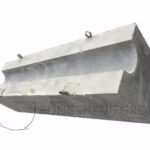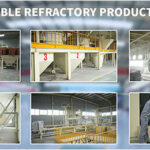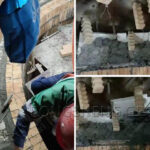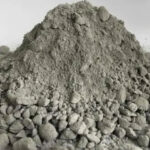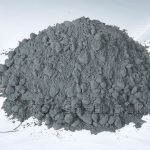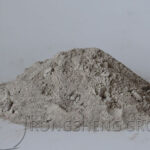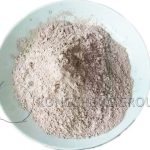In recent years, the output of unshaped refractory products has become higher and higher, and their application range has become wider and wider. Refractory castables do not need to be fired at high temperatures and can be used directly after being baked during construction. It is a new refractory material with a simple production process, saving energy and labor, mechanized construction, good integrity, easy repair, and long life.
Refractory castables are a type of refractory material that is mixed with a certain grade of refractory aggregates and powdery materials, binders, and admixtures and is used directly without going through the molding and firing processes.
According to the combination of raw materials, refractory castables can be divided into oxide refractory castables, non-oxide refractory castables, and composite refractory castables. Oxide refractory castables can be subdivided into non-alkaline refractory castables and alkaline refractory castables. Therefore, the performance of refractory castables mainly depends on the raw materials used in the formulation. In order to improve the performance of refractory castables, most manufacturers have used high-purity raw materials, homogeneous materials, electrofusion materials, synthetic materials, transformation materials, and ultra-fine powders as main raw materials. Let’s talk about the 24 raw materials that are often used in the formula of refractory castables.
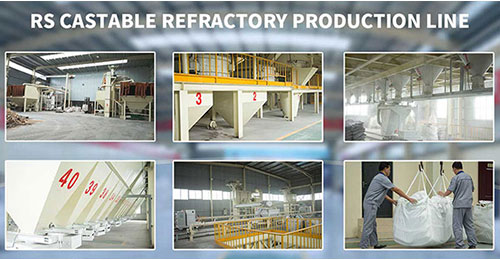
The Main Raw Material of Refractory Castables (13-24)
(13) Magnesite.
Magnesite is a natural alkaline mineral raw material with magnesium carbonate (MgCO3) as the main component. Our country is rich in magnesite resources, with high quality and large reserves. Magnesite is mainly distributed in Liaoning Province. Magnesite is mainly used to produce sintered magnesia, fused magnesia, and raw materials for the production of alkaline refractory materials.
(14) Sintered magnesia.
Sintered magnesia is a product obtained by fully sintering magnesite at 1600~1900℃. The main mineral is periclase. The MgO content of high-quality magnesia is generally above 95%, the particle volume density is not less than 3.30g/cm3, and it has excellent resistance to alkaline slag erosion. Sintered magnesia is one of the main raw materials for the production of alkaline refractory materials.
(15) Fused magnesia.
Fused magnesia is made by melting selected magnesite or sintered magnesite at a high temperature of 2500°C in an electric arc furnace. Compared with sintered magnesia, the main crystal phase periclase grains are coarse and in direct contact, with high purity, dense structure, strong resistance to alkaline slag, and good thermal shock stability. It is a good raw material for high-grade carbon-containing unburned bricks and amorphous refractory materials.
(16) Silicon carbide.
Silicon carbide is usually made from a mixture of coke and silica sand as the main raw materials through high-temperature smelting in an electric furnace. β-SiC (cubic crystal) is generated at a temperature of 1400-1800°C, and α-SiC (hexagonal crystal) is generated when the temperature is higher than 1800°C. Silicon carbide has high hardness, high thermal conductivity, low thermal expansion rate and excellent resistance to neutral and acidic slag. The composition range of commercial silicon carbide is 90%~99.5% SiC. Refractory castables, gunning materials, ramming materials and plastics often use silicon carbide with higher purity.
(17) Silica fume.
Silica fume is a by-product of the production of ferrosilicon and silicon products. Appearance: white to dark gray fine powder with round particles. The particle diameter is generally 0.02~0.45μm, the specific surface area is about 15~25m2/g, and the volume density is 0.15~0.25g/cm3. In recent years, some silica fume has become the leading product and is no longer a by-product. It has high purity, white color and stable ingredients. Shows good rheology when used in self-flowing castables.
(18) Graphite.
Graphite is divided into artificial graphite and natural graphite. Artificial graphite is made by sintering petroleum coke (heating to above 2800°C) or using graphite electrodes. Natural graphite crystal is a hexagonal crystal system with rhombohedral symmetry. There are usually three forms: amorphous, flake graphite and pure crystalline. Amorphous graphite (no form) and artificial graphite have better fluidity than flake graphite and crystalline graphite in castable applications.
(19)Asphalt.
Coal tar pitch has a higher residual carbon content than petroleum pitch, and both can effectively provide carbon components to refractory materials. According to the formula design requirements of the material, it can be used in the form of fine powder or granules. The use of bitumen is preferred over other forms of carbon (such as graphite) in amorphous refractory applications. Because asphalt has a low melting temperature, it can coat particles and thus provide a good protective layer against slag erosion.
(20) Calcium aluminate cement.
The main method for producing high alumina cement is the sintering method. Pureer limestone is the calcium oxide raw material from which all calcium aluminate cements are produced. Sintered alumina is used to produce high-grade calcium aluminate cement, while low-iron, low-silica bauxite is used as alumina raw material for mid-grade and low-grade high-alumina cement. Pure calcium aluminate cement or high alumina cement is the most important hydraulic cement used in the binding phase of refractory castables and shotcrete. During the construction of the refractory castable lining, the water temperature, water addition amount, mixing intensity and time, temperature and heating rate must be strictly controlled. Among them, temperature is the most important parameter, which significantly affects the generation of cement binding phase and the discharge of water in the early stage of heating.
(21) Silica sol.
Silica sol is a water-containing colloid with dispersed silica particles. It is a milky white liquid that is slightly sticky to the touch and has a high specific surface area. Silica sol can be cemented by dehydration, changing the pH value, adding salt or water-miscible organic solvents. When drying, silicon-oxygen (Si-0-Si) bonds are formed on the surface of the particles through rapid dehydration, resulting in polymerization and internal bonding. Silica sol is converted from solution into solid, commonly known as cementation. Commonly used in coatings, castables, pumped materials, ramming materials and gunning materials.
(22) Sodium silicate.
Commonly used silicates are sodium silicate (Na₂O·mSiO·nH₂O), potassium silicate and lithium silicate. The dehydrated product of sodium silicate is usually as transparent as glass and soluble in water, so it is also called water glass. The molar ratio of SiO₂/N₂O (called the modulus of water glass) in industrial products is between 0.5 and 4.0, and the molar ratio of sodium silicate for refractory materials is 2.2 and 3.35. The viscosity of sodium silicate aqueous solution is affected by its molar ratio and concentration, and changes significantly with temperature. Sodium silicate hydrates in aqueous solution, and the solution becomes alkaline. The smaller the molar ratio, the more obvious the hydration of sodium silicate is, and the pH value decreases as the molar ratio decreases. Sodium silicate with a high molar ratio reacts slowly. The choice of curing agent for sodium silicate combined refractory materials needs to be determined based on the application of the refractory materials. Commonly used curing agents include sodium fluorosilicate, polyaluminum chloride, phosphoric acid, sodium phosphate, polyaluminum phosphate, polymagnesium phosphate, ammonium pentaborate, glyoxal, citric acid, tartaric acid, ethyl acetate, etc.
(23) Phosphoric acid and phosphate.
Orthophosphoric acid itself has no binding properties. When it comes into contact with refractory materials, the two react quickly to form phosphate, which makes it show good adhesion. Different forms of phosphates can be used as binding agents. The salt most commonly used in refractory materials is aluminum phosphate. As a binding agent, aluminum dihydrogen phosphate is known for its solubility in water, binding strength and stability. Sodium phosphate is mainly used in refractory materials for cohesion, depolymerization and as a binding agent for alkaline gunning materials. Sodium polyphosphate is often used as a water reducing agent in castables. In addition, sodium phosphate can react with alkaline earth metal compounds (such as CaO and MgO), resulting in agglomeration. It is based on this performance of sodium phosphate that it is used in magnesia alkaline gunning materials.
(24)ρ-Al₂O₃
ρ-Al₂O₃ is a kind of activated alumina. It is different from other crystalline Al₂O₃ and is the worst crystallized Al₂O₃ variant. Among the various crystal states of Al₂O₃, only ρ-Al₂O₃ has a spontaneous hydration reaction at room temperature. The gibbsite and boehmite sol generated by hydration can play a cementing and hardening role. ρ-Al₂O₃ is eventually transformed into α-Al₂O₃ (corundum), an excellent refractory material at high temperatures. Therefore, this ρ-Al₂O₃ combined castable can be regarded as a self-bonding castable of refractory materials, which also acts as a binder. It itself is a high-grade refractory oxide with obvious excellent properties.
(THE END)
By selecting different raw materials as the main raw materials of refractory castables, castables with different properties, operating temperatures, and ranges can be made. Of course, only the main raw materials are not enough. Binders, admixtures, and some special additives are also needed. These are all to improve the performance of refractory castables. Rongsheng Unshaped Refractory Castables Manufacturer is a powerful manufacturer and seller of refractory castables. Our environmentally friendly, fully-automatic unshaped refractory material production line provides high-quality customized refractory lining materials for high-temperature industrial furnaces. Contact us to get a free refractory lining solution and quote.

